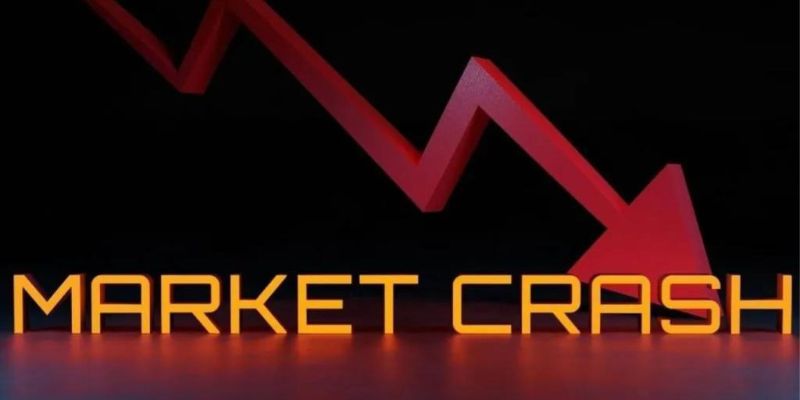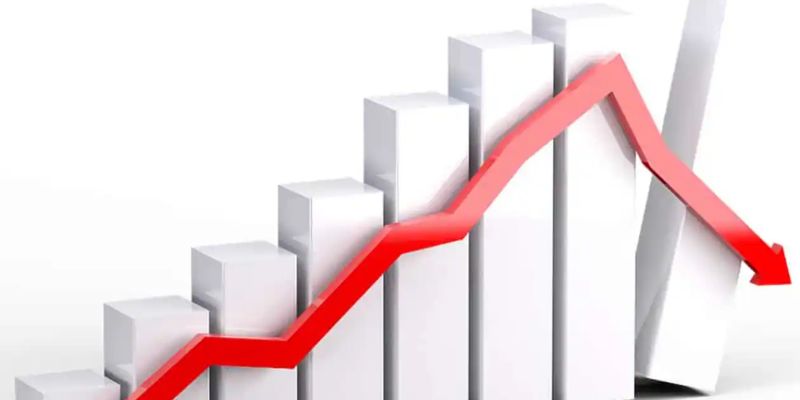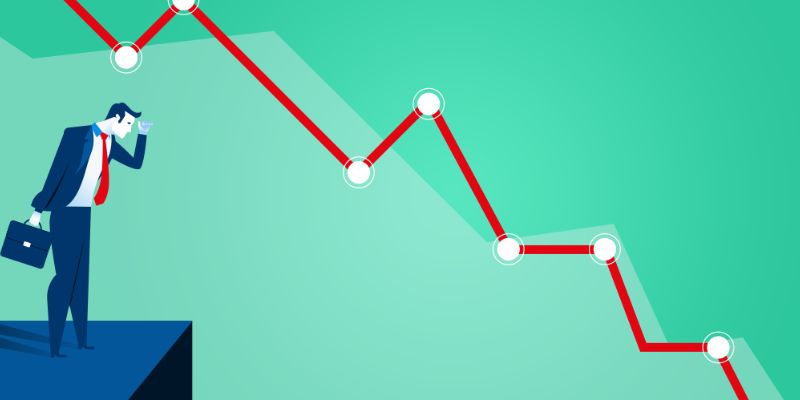Are your hard-earned dollars in danger? In a blink, a booming stock market can quake, signaling a drop no one hoped for. Signs of a stock market crash sneak up, but with sharp eyes, you can spot them. Price spikes and overvalued stocks often pave the way for a tumble. Flustered markets and wild stocks tell a tale of worry. Stay ahead; know the signs and keep your investments safe. Let’s dive in and learn how to shield your financial future.
Identifying a Stock Market Bubble: Early Warning Signals
High Price-to-Earnings Ratios and Stock Valuation Excess
Have you seen stock prices soar while company earnings lag? That’s a high price-to-earnings ratio. It can signal stock valuation excess. This ratio compares a company’s share price to its earnings per share. A high ratio may mean stocks are overpriced. It’s a classic sign of a stock market bubble. Investors should watch out when these numbers fly too high. This is especially true if earnings don’t back up the price jumps.
Stocks with sky-high prices can be risky. They may fall hard when reality hits. Think of it like a rubber band stretched too far. It has to snap back at some point. And when it does, prices can crash. This can hurt your investments.
Market Bubble Characteristics and Overheated Economy Signals
Talking about market bubbles, let’s dig deeper. Market bubbles happen when prices go up more, more, more—way beyond what’s reasonable. Everyone’s buying, but not because of how companies perform. They buy because they see prices going up. That’s a bubble. And it has to pop.
When too many people invest with hopes for quick gains, that’s a red flag. It means the market could be on steam, not solid gains. And there are more signs. If you see a big bunch of IPOs, that’s companies going public fast, think twice. Or if some sectors shoot up while others don’t, ask why.
A super hot economy can also make you stop and think. When jobs are everywhere and folks spend cash like there’s no end, caution. It feels nice, but it’s not normal. Prices for houses, food, and more can leap too. And high debts can come next.
Keep in mind, not one sign spells doom alone. You gotta watch them all. When these warning signs bunch up, it’s time to act smart. Talk to pros, read up, and stay sharp.
Remember, your money’s your future. You worked hard for it. Don’t let a market bubble burst it. Keep an eye on those ratios and signals. They tell a story you need to know. If you’re careful, you can keep your investments safe even when warning bells ring.

The Role of Monetary Policy and Leveraged Practices
Interest Rate Hikes and Effects on Stocks
When the central bank boosts interest rates, it gets expensive to borrow money. Firms can’t get cheap loans to grow. People spend less as their debt costs more. This can cause stock prices to fall. Many investors sell shares, fearing lower profits and slow growth. When borrowing gets more costly, some sectors suffer a lot. Think of builders or car makers who need loans for big projects. Their stocks might drop first when rates go up.
Excessive Leverage Risk and Credit Market Contraction
Banks and investors sometimes use big loans, or “leverage,” to magnify their returns. This works well when markets go up. But it’s a huge risk during downturns. Imagine you borrow money to invest, and then the stocks plunge. You’d still owe the bank, but your stocks are worth less. That can lead to fast sell-offs in the market. Credit markets can shrink too. If banks fear not getting paid back, they lend less. Smaller firms that rely on loans may suffer, and their stocks can dive. It’s like a row of dominoes. One falls, they all might.
Folks, keeping an eye on these two signs can help protect your investments. When rates rise or credit dries up, it may be time to think hard about where your money sits. The market can be a rough sea. Watching out for these warnings helps us navigate through potential crashes.
Behavioral Insights: Investor Actions and Market Reactions
Investor Sentiment Shift and Insider Trading Patterns
Ever notice how people act when it’s time to sell or buy stocks? They follow patterns. For example, if folks are scared, they might sell stocks. This is a shift in investor sentiment. And it’s a big warning sign of a market downturn.
Now, what about the big bosses, the insiders of companies? They know the inside scoop. If they sell a lot of their stock, watch out. It could mean they see trouble coming. Insider trading patterns can really tell us where the market’s headed. Let’s look deeper at this.
When bosses start to sell their shares in bunches, we sit up and take notice. They have the first news on their company’s health. A sell-off can hint at a company expecting bad times. If many companies in the market show this pattern, it can be a sign of a bigger problem.

Unusual Market Volatility and Trading Volume Anomaly
Have you ever been on a roller coaster that suddenly drops? That’s volatility in the stock market, and it’s a sign that stocks might crash. It means prices are jumping up and down more than normal. Big swings in price can scare people, and scared people may pull their money out of the market.
Also, let’s chat about trading volume. That’s how many shares people trade. Sometimes, there’s a weird spike or dip which doesn’t match the norm. We call this a trading volume anomaly. This can mean folks are buying or selling lots of shares in a panic or rush. When all this trading doesn’t add up, it can mean trouble for the market.
So, keep an eye on how many shares are changing hands. If it’s a wild number without clear reason, it’s like a bright flashing light telling us to be careful. When share prices act like a yo-yo and trading goes wacky, we’ve got clues something’s off.
In short, by watching how bosses deal with their shares and the market doing the jitterbug, we learn a lot. These signals can shout, “Hey, be careful! A market crash may be just around the corner.” It pays to watch these signs. They can help save your investments from a big fall.
Macro Indicators and Their Impact on Market Stability
Yield Curve Inversion and Consumer Confidence Decline
Picture this: you’re in a boat, and the water starts to swirl. It’s like that with yield curve inversion. This happens when short-term interest debts cost more than long-term ones. It’s often a warning sign of a stock market downturn. People get nervous. They stop buying as much because they’re unsure about the future, just like when consumer confidence goes down before a market crash. That’s when folks are less eager to spend money, figuring tough times might be ahead.
Now, let’s dig deeper. Say our yield curve flips – usually, you’ll get more cash for locking up your money longer, right? But not during an inversion. It can mean a big mess is coming. Experts look at this and say, “Watch out! Trouble might be brewing.” They know the economy might slow down or even shrink. When people sense a downturn, they hold on to their cash. They’re less likely to buy that new car or kitchen. It’s a cycle – less spending leads to slower business, which can mean an economic slump.
Let’s break it down into simple bits: A normal yield curve goes up, showing more money for long-term investments. But in recent years, when this flipped, it was spot on in signaling recessions within two years. So, it’s like your check engine light. It might not mean a breakdown today, or tomorrow, but it’s a heads-up to get ready.
Sector Performance Inconsistency and Geopolitical Tensions Effects
Now, let’s chat about why it matters if all business sectors aren’t doing the same dance. Maybe tech stocks shoot up, but banks and builders lag big time. This is called sector performance inconsistency. It’s important because harmony in how sectors move points to a stable market. Little red flags pop, warning us of economic predictors of a market crash when they’re out of sync.
Another thing to keep an eye on is the big world picture – geopolitical tensions. Like when countries don’t get along, it can jumble up the stock market. Stocks can drop fast if things get heated between big nations, or if there’s uncertainty about what leaders will do next. If a new rule comes out that changes how companies can act, that’s a regulatory change, and it can shake things up in the markets too.
Here’s more detail: when sectors zigzag differently, it might mean investors are not sure where to put their money. They could be running from riskier parts of the market to safer ones. When big world events toss and turn, or new rules come out, it hits confidence. People who invest sometimes rush to sell if they think things will get rocky. It’s all about feeling safe with where your money is. If that feeling goes away, watch out!
Watching these signals, like yield curve inversion and sector zigzags, is like being a weather forecaster for stocks. You look for patterns and changes to keep your money safe from storms. So, keep your eyes peeled, and listen to what these market signs are telling you. They could help you steer clear of trouble in your investment journey.
In this post, we looked at the signs of a stock market bubble, like sky-high stock values and an economy running too hot. We saw how interest rates and big loans can shake stocks up. We also spotted warning signs in how people buy or sell stocks and when the market jumps around a lot. Lastly, we saw how big-picture stuff, like changes in long-term loans and how people feel about spending, can mess up the market.
Now, let’s be real. Spotting a bubble in stocks isn’t easy, but knowing these clues helps a bunch. Watch for these signs, make smart choices, and don’t get caught when a bubble pops. Keep those eyes wide open! It’s about staying smart and staying ahead. The market will always have ups and downs, but with a sharp eye, you can keep your money safe and sound.

Q&A :
What are common indicators of a potential stock market crash?
The stock market is complex and can be influenced by a myriad of factors, but certain indicators are often linked to potential crashes. These can include a significant decline in stock prices, a high price-to-earnings (P/E) ratio compared to historical averages, rising interest rates, widespread speculative trading, political instability, or economic signs such as a rapid drop in consumer confidence or a steep yield curve inversion. Keeping an eye on these signals can help investors gauge the market’s health.
How does investor behavior change prior to a stock market crash?
Before a stock market crash, investor behavior can exhibit several warning signs. One primary indicator is excessive optimism and speculative investments, where investors may overlook fundamental risks in search of high returns. Similarly, there may be a noticeable increase in leveraged positions, where investors borrow money to invest more heavily in the market. Increased trading volumes, particularly in volatile stocks or those disconnected from their inherent value, can also precede a downturn.
Can economic reports predict a stock market crash?
Economic reports can provide valuable insights into the health of the economy, which in turn may indicate the likelihood of a stock market crash. Reports detailing slowing economic growth, high unemployment rates, decreased consumer spending, or widespread business bankruptcies can all be harbingers of a potential market downturn. It is important, however, to understand that while economic reports can signal potential trouble, they are not foolproof predictors, as stock markets can be influenced by unpredictable events and investor sentiment.
What role do interest rates play in forecasting a stock market crash?
Interest rates hold a pivotal role in the economy and can impact the stock market significantly. When interest rates rise, borrowing costs increase, which can dampen corporate profits and reduce consumer spending. This, in turn, may lead to lower stock prices. If rates rise too quickly or too high, it could potentially precipitate a market crash. Additionally, high interest rates make bonds and other fixed-income investments more attractive compared to stocks, which could lead to a shift in investment patterns and a potential sell-off in the stock market.
Are there any historical patterns that can help identify a future stock market crash?
Understanding historical stock market crashes can be instrumental in identifying patterns that may hint at future crashes. Factors like market bubbles characterized by unsustainable, rapid price increases, extreme valuations in stocks, overly bullish investor sentiment, and sudden shifts in monetary policy have been present during past crashes. While history can offer lessons, it is also crucial to remember that the stock market is dynamic, and past patterns do not guarantee future outcomes. Each potential crash might have unique triggers and evolve under different economic contexts.

